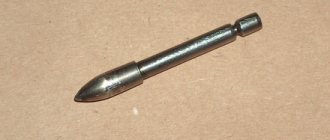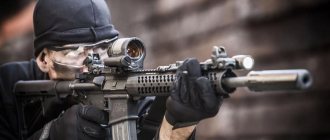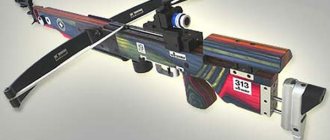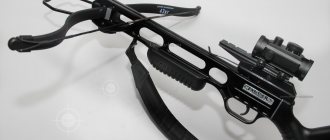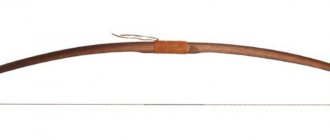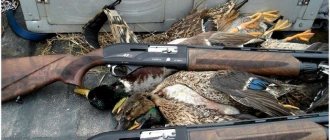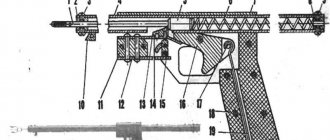Tactical crossbows in the army
From the history of throwing weapons used for military purposes
Military technologies are constantly being improved and developed, design bureaus and research institutes almost every day produce ultra-modern weapons - tanks and missiles, warships and aircraft. And it seemed that there were no limits to the imagination of engineers and scientists - they invent equipment with the help of which special forces soldiers can perform the most complex combat missions in a wide variety of climatic and tactical conditions. The equipment of Russian special forces was shown at the military parade, but this is only a small part of what was presented to the general public.
But no matter how sophisticated the designers become, combat knives, axes, bows and crossbows are still extremely popular among the military. In many countries around the world, special forces soldiers still have combat crossbows in their arsenal! So what attracts intelligence officers and saboteurs to weapons that were outdated half a millennium ago? To answer this question, let's try to look at where and when crossbows appeared. The invention of this most effective throwing weapon is attributed to the Chinese, although crossbows, albeit in a slightly different form, were also found in Rus'. They were called crossbows and were used mainly for hunting. In Western Europe, crossbows served as weapons for killing their own kind and were in service with the armies of many countries until the 16th century.
Differences in the design and materials of ancient and modern crossbows
Due to the high cost of carbide metals from which the bowstring lock was made, in the early Middle Ages, a crossbow cost the price of five good recurve composite bows. Therefore, the peak of the spread of crossbows among troops occurred in the 11th century, during the years of the invention of a relatively inexpensive steel alloy. Undoubtedly, the design of a modern crossbow is tens of times more complex than their distant ancestors, but the principle of operation remains the same: the transfer of the kinetic energy of the bowstring to the bolt (arrow) and the higher the tension force, the further and higher the speed of its flight.
To make crossbows, our ancestors used wood, animal skin and bones, and steel. The latter were used for the manufacture of arcs, which made them stronger and more elastic, and also minimized return parasitic movements and vibration. Modern crossbows use completely different materials, with the exception of steel, but it is naturally of a higher quality: it does not rust, does not wear out or “get tired” even after decades of intensive use.
The wooden shoulders of ancient crossbows could barely withstand a thousand shots, and the tension force was equal to the proportion of their size, that is, the more powerful the crossbow, the larger its shoulders and, accordingly, its size. The metal shoulders made the weapon ten times heavier, and the metal was very expensive, but the tension force was truly fantastic: up to 600 kg! With such power, the heavy metal bolt retained its destructive power at a distance of up to 600 meters. True, the metal of the shoulders could not withstand frost and the crossbow quickly wore out.
A modern crossbow, the arms of which are made of carbon fiber, is designed for 10 thousand shots at maximum load and has a maximum tension force of up to 85 kg/s. Considering that modern crossbows are designed more for hunting and sabotage operations than for full-fledged combat, when getting as close to an animal or enemy as possible, this is quite enough.
The string of ancient crossbows was made of woven linen threads treated with a special impregnation that prevented rotting and stretching. Also, horsehair was used as an alternative. The strength of this bowstring was not inferior to steel wire, although the price was exorbitant! For very powerful large crossbows, the bowstring was woven from bull tendons. An arrow fired from such a crossbow pierced a steel sheet 3 mm thick from a distance of 30 meters, a leather shield 120 meters and struck to death a warrior dressed in light armor, pierced through an oak board 90 mm thick. As we can see, the crossbow was a formidable deadly weapon that terrified the opposing sides.
A modern bowstring is made of high-strength braided polymer threads that can withstand up to 8 thousand shots. The striking power of such crossbows is inferior to ancient heavy-duty weapons, but it is quite sufficient for covert sabotage and reconnaissance operations and successful hunting of large animals from a distance of up to 25 meters. And the weight of a modern arrow is 40-50 g, while the average weight of an ancient bolt was 150 g, and in powerful crossbows - up to 600 g! Such a high mass maintained the impact force of a crossbow bolt up to 400 meters.
By the beginning of the 18th century, crossbows were completely replaced by muskets, pistols, and other firearms, and they were used only as exotic hunting entertainment for the rich. During the First World War, infantrymen remembered crossbows - they used heavy crossbows as grenade launchers, successfully throwing grenades at enemy positions at distances of up to 500 meters.
After World War I, the troops forgot about crossbows for more than half a century. They were remembered in the 60s, at the height of the Cold War, when reconnaissance and saboteurs began to need silent, effective weapons. In the USSR they were practically not used, but in the USA, where they loved all kinds of exotic things, engineers appeared who tried to create powerful and compact crossbows. However, the materials and technologies available at that time did not allow the creation of sufficiently effective military weapons.
Decades have passed, computer technology and modern materials have made it possible to create excellent tactical crossbows for army reconnaissance. This is not necessarily a weapon for hitting living targets or installing a tip with an explosive grenade, etc., but a means for throwing communications and tracking equipment into trees, protected areas, silently obtaining food in the forest, etc. With the help of crossbows you can overcome obstacles - rivers, gorges , throwing a thin cord over the abyss to the other side. An arrow fired from a modern combat crossbow retains its destructive power at a distance of up to 300 meters and even a bulletproof vest cannot save a fighter.
Crossbow for survival "Aspid-18"
- A little testing of the Aspid-18 Crossbow
Attention!
The boxed set is now in stock! Instead of a case - a spare bowstring! A lightweight pistol-type crossbow, the most famous and time-honed Aspid model.
“Aspid” - Option with 18 kg. tension force, designed to be compact .
Has almost no recoil, and is unusually silent.
The tri-functional crossbow pistol fires darts, balls and harpoons. The crossbow-pistol has a durable cast body made of light alloy, reliable composite shoulders with a pulley system. A steel cable is used as a bowstring. Thanks to a special cocking system, the crossbow is very convenient and easy to cock, thereby achieving high accuracy of fire. The crossbow is equipped with an open mechanical sight with the possibility of adjustments. There are also 2 dovetail rails for mounting a laser pointer or a small optical or red dot sight. Shooting with dart arrows - the aiming range is 15 meters (to achieve greater accuracy, it is better to use special two-feather arrows made of aluminum or carbon fiber. Shooting with harpoon arrows - the aiming range is up to 20 meters. Thanks to the inertia-free reel, which is mounted on the front part of the crossbow, the thread comes off almost without resistance and the accuracy and firing distance practically does not affect. Shooting with balls - the target range is up to 10-15 meters. The advantage of this model is a special tube clip, thanks to which you can charge several balls (magnetic system), due to which the rate of fire significantly increases. ( ATTENTION: ricochets and bounces are possible).
The Aspid crossbow pistol is an excellent option for recreation and entertainment with great functionality and high shooting accuracy.
Equipment:
- Plastic dart arrows – 3 pcs.
- Plastic harpoon arrows - 3 pcs.
- Weighted darts - 2 pcs. (not included in the boxed version)
- Balls 6 mm. — 25 pcs.
- Inertia-free reels for harpoons, with threads – 3 pcs.
- Spare string
No permit required to purchase/wear/use. It is enough to have only the ECC certificate of the Ministry of Internal Affairs of the Russian Federation with you. You will receive a copy of the certificate when purchasing goods in our store.
Note:
Chosen by our Community as the Survival Crossbow. The decision was made to choose the best model available, and try to make the LOWEST price possible.
Tests and selection of the crossbow were carried out for about six months, taking into account:
- Dimensions
- Power
- Multifunctionality
- Price
- Strength
- Possibility of repair
Characteristics:
- magnetic cage capacity for balls (6 mm): 15pcs
Block crossbows have a greater reserve of power and energy, and improved technical characteristics compared to recurve crossbows. Thanks to the eccentrics, cocking the bowstring is easier and, as a result, the load on the lock is reduced. Arrow acceleration in a block crossbow is smoother. With a recurve crossbow, the peak load on the arrow occurs at the beginning of its movement, and then it drops sharply. In a block crossbow, it’s the opposite: the load gradually increases as the arrow moves (thanks to the eccentrics), and becomes peak in the last third of the movement. In total, with the same tension force, the efficiency of a compound crossbow is higher than that of a recurve crossbow by approximately 30%. The bow of the crossbow consists of two folding arms. Thanks to this, the crossbow is convenient for transportation - it is quickly assembled and disassembled. In 20 minutes, the Aspid can fire more than 300 ball shots and 100 arrow shots. The crossbow is similar in weight and size to an air pistol. Convenient cocking, facilitated by the block system, is done using a lever on the back of the crossbow. The fuse trips automatically.
Other guides
- What workshops are best to buy in Mount & Blade 2: Bannerlord
- Codes and console commands in Mount & Blade 2: Bannerlord
- How to become the owner of a town or village in Mount & Blade 2: Bannerlord
- What to do with prisoners in Mount & Blade 2: Bannerlord
- Tips for creating a character in Mount & Blade 2: Bannerlord
- Bugs and errors in Mount & Blade 2: Bannerlord - what to do?
- 25 Tips for Mount & Blade 2: Bannerlord Newbies
- How to increase Influence in Mount & Blade 2: Bannerlord
- How to get married and have children in Mount & Blade 2: Bannerlord
- How to earn more gold in Mount & Blade 2: Bannerlord
All guides and tips for Mount & Blade 2: Bannerlord →
- How to earn more gold in Mount & Blade 2: Bannerlord
- How to increase Influence in Mount & Blade 2: Bannerlord
Crossbow - underwater hunting tool
Indeed, it is almost impossible to use this tool for spearfishing. The main reason lies precisely in the water, which, having strong resistance, will slow down the movement of the shoulders and the flight of the weapon directly at the animal. The result of such a “hunt” will be depressing. If the hunt is for a large predator, then it is completely deplorable. But a crossbow for spearfishing can be used, if not under water, then in shallow water. But here a problem arises: the design of the crossbow is special and complex.
And it is not at all designed for spearfishing. To do this, a person needs to know certain rules and examples that will help him subsequently cope with this hunt and get a successful catch. Without knowing these rules, you can stumble upon a seemingly funny, but seemingly not the most pleasant problem, when the crossbow will not be able to shoot or will shoot, but with a very noticeable problem. What should I do? This situation needs to be sorted out. There are many different examples of crossbows that you can use to practice your design. First you need to practice on a crossbow called “Aspid”.
This crossbow, of course, is low-powered, but in this situation it is very suitable, since it has harpoons with reels. This design is very simple, in contrast to the design of crossbows such as the Scout and Scorpion. They have a special reel with fishing line, unlike the previous crossbow. This feature is very interesting, since the fishing line, unlike a harpoon, cannot be put anywhere. Unless the crossbow has a double hole, where this tool fits without any problems. It is also very important to disassemble the harpoon so that the recoil is too powerful.
